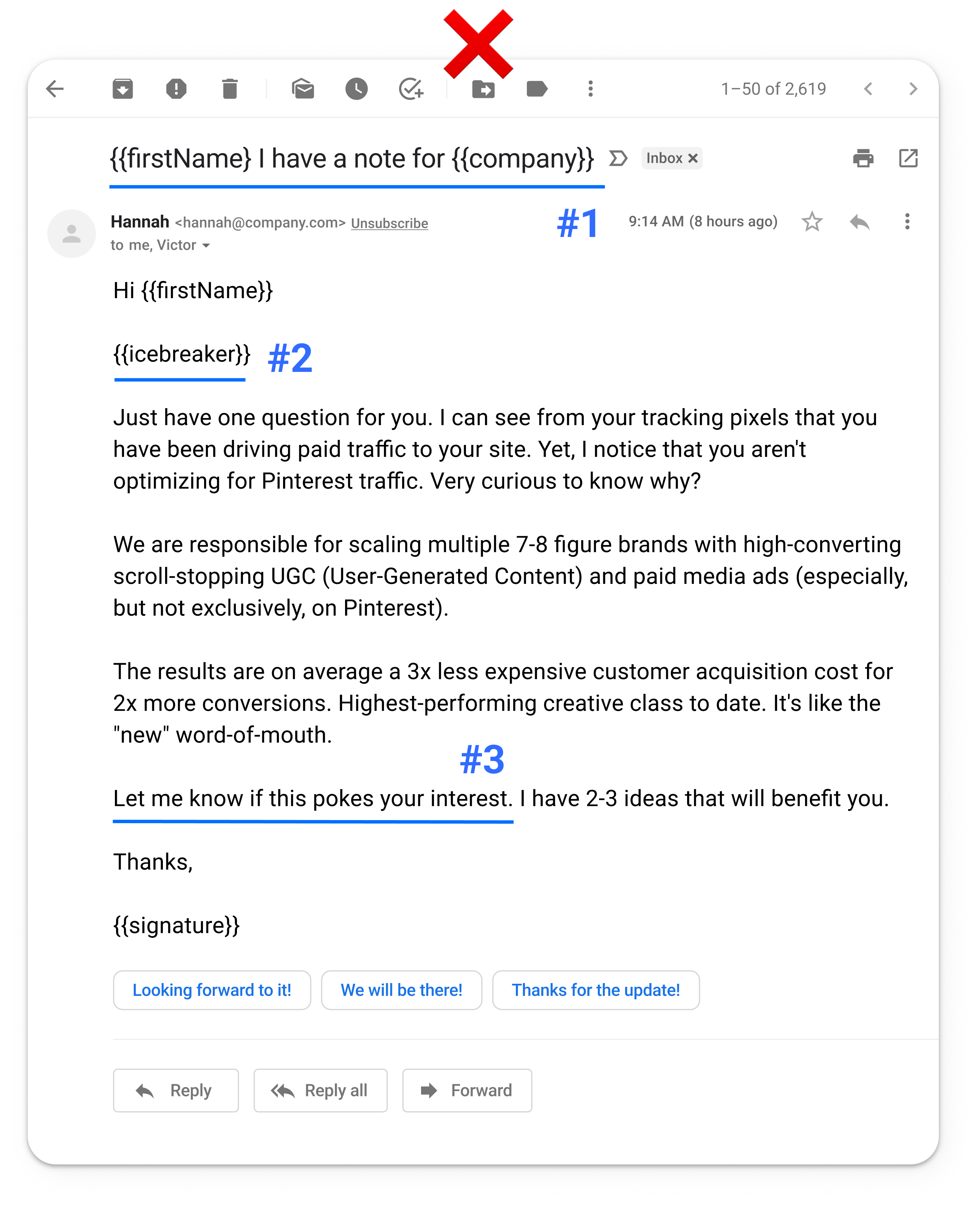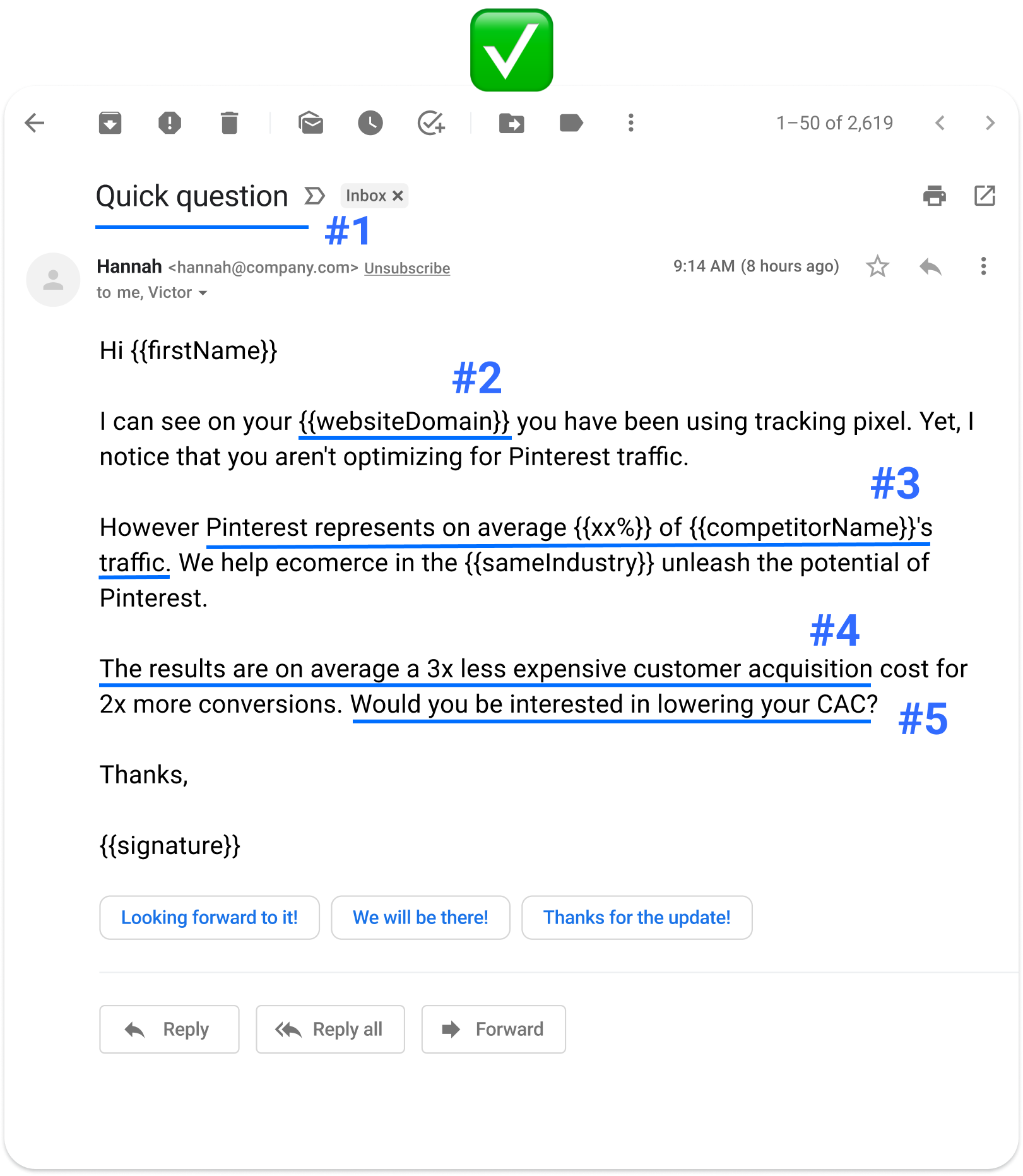Pitching your solution to e-commerce decision makers and booking meetings with them can be challenging.
They receive so many cold emails per day, making it hard to stand out and catch their attention.
So, how do you ensure your pitch doesn’t come off sales-y, but genuinely gives value and sparks their interest?
In this article, Victor, the Co-founder of Scalability, breaks down a typical cold email with all its weak spots and shows you how to start meaningful conversations!
Cold email mistakes to avoid
Your goal is to book more meetings and ultimately close more deals, but there are some things that you may be doing wrong in your cold emails.
Here’s a cold email that targets e-commerce businesses who don’t advertise on Pinterest

Let’s see what mistakes Victor recommends you avoid for more replies:
Mistake #1: Sales-y subject line
If you want to make your cold email subject line stand out in 2023, you’ll have to make more effort than using the target’s name and company name.
Here are a few ideas from Victor:
→ boost curiosity with a short question
→ make it look like an internal email by using the language of leads’ colleagues
→ keep it short so it stands out from other marketing emails
Mistake #2: Use icebreaker only if it’s relevant
Use an icebreaker only if it makes sense, and it fits well with the rest of your cold email. It should reply to “why them”.
Mistake #3: CTA is not a question
Having a question in your email closing is important as it pushes an answer from your leads and makes your message more engaging.
How to write a cold email for a high conversion rate
Here’s how Victor would rewrite this cold email and her tips for more replies:

Tip #1: Write an intriguing subject line
Catch prospects’ attention with a short yet intriguing subject line. This proves you don’t always have to use custom variables to stand out in the target audience inbox.
Tip #2: Use website custom variable
By mentioning your prospects’ website and its details, you can show you did the proper research and make the rest of your message seem more relevant.
Tip #3: Mention competitors’ success
By mentioning competitors that are highly similar to your prospect, you will make them curious about how they achieved their success. You can position yourself as an expert who can bring them the same or even better results!
Tip #4: Share relevant industry metrics
By sharing industry trends relevant to your prospects’ desired outcomes, you can showcase your expertise and that you understand their challenges.
Tip #5: Add a question that is easy to reply “yes” to
Use interest-based obvious questions to make it easy to reply “yes” to. This removes friction for your prospects and boosts your chances for a reply.
Cold email template to replicate for more replies
Subject line: quick question
Hi {{firstName}}
I can see on your {{websiteDomain}} you have been using tracking pixel. Yet, I noticed that you aren’t optimizing for Pinterest traffic.
However, Pinterest represents on average {{xx%}} of {{competitorName}}’s traffic.We help e-commerce in the {{sameIndustry}} unleash the potential of Pinterest.
The results are on average a 3x less expensive customer acquisition cost for 2x more conversions.
Would you be interested in lowering your CAC?
Thanks,
Signature
Key takeaways
If you want to get replies to cold emails targeting e-commerce businesses:
→ Craft an intriguing subject line that stands out.
→ Highlight genuine research, such as referencing the prospect’s website.
→ Point out competitors’ successes to pique interest.
→ Conclude with a straightforward question that’s easy to say ‘yes’ to.
You can watch Victor’s full cold email teardown here!
PS: Want more tips? Request outbound experts to review your cold emails here!
Your source of actionable outreach tips and strategies that will help you get replies and grow your business.

